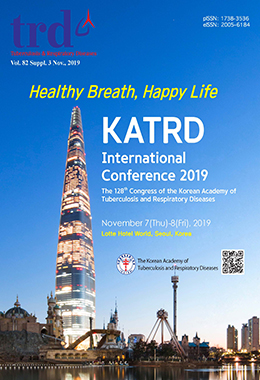Background: Humidifier disinfectant (HD)-associated interstitial lung disease (ILD) has been reported in South Korea since 2006, with high mortality rate(43.3%, 205/474). Patients with HD-associated asthma (HDA) have been recently recognized as victims; however, their pathogenesis and clinical characteristics have not been completely investigated. Penetration of hydrophilic HD aerosols(100nm sized polymers) into the peripheral lung regions damages the small airways and surrounding lung parenchyma, which can precede observable radiological abnormalities. Given that the airway injury might have induced bronchial hyperreactivity leading to asthma-like symptoms in HDA, we hypothesized that HD exposure correlates with the decreased diffusing capacity for carbon monoxide (DLCO) despite no radiological chest abnormalities compared to typical asthma. Methods: From health insurance claims data, HDA cases were identified by their international classification of disease- 10 code and treated with anti-asthmatics. Despite past asthma diagnosis, cases that worsened during the exposure period were enrolled. Patient information was collected retrospectively from medical records and environmental exposure questionnaire. Adult HDA patients were included; those with ILD were excluded (Figure1). Cases were grouped based on HD exposure: definite(D), probable(Pr), possible(Po), and unlikely(U). Each group’s DLCO% and correlations among cumulative usage time categories were analyzed using the Jonckheere-Terpstra test and Spearman rank test, respectively. Results: Of 298 HDA patients, 109 were enrolled. Baseline mean age was 48 years; 47.7%(n=52) were men; 34.9%(n=38) were non-smokers; mean FVC% predicted was 84.4%; FEV1%, 73.9%; and DLCO%, 82.3%. The number of patients and DLCO% predicted(mean±standard deviation) in each group were D(n=31, 75.4±24.4%), Pr(n=35, 85.2±18.7%), Po(n=38, 82.9±18.7%), and U(n=5, 99.7±20.9%); p-value for trend=0.04. DLCO% and cumulative usage time showed significant negative correlation(r=-0.229; p=0.019). Conclusions: In adults with HDA, DLCO% decreased as exposure class or cumulative usage time increased. Long-term HD exposure might have injured the small airway and surrounding lung tissues without evident radiological chest abnormalities.


